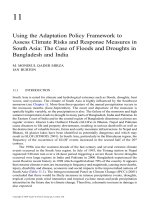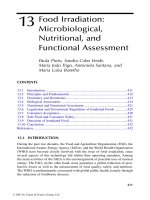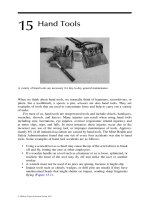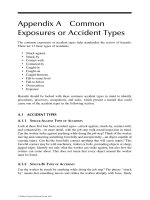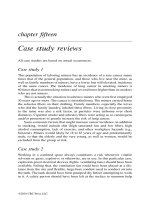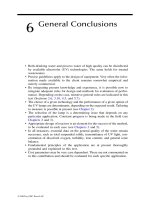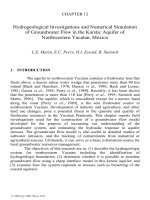Drought and Water Cruises: Science, Technology, and Management Issues - Chapter 15 (end) pdf
Bạn đang xem bản rút gọn của tài liệu. Xem và tải ngay bản đầy đủ của tài liệu tại đây (504.49 KB, 11 trang )
Part IV
Integration and Conclusions
DK2949_book.fm Page 387 Friday, February 11, 2005 11:25 AM
Copyright 2005 by Taylor & Francis Group
389
15
Drought and Water Crises:
Lessons Learned and
the Road Ahead
DONALD A. WILHITE AND
ROGER S. PULWARTY
CONTENTS
I. Introduction 389
II. Moving from Crisis to Risk Management:
Changing the Paradigm 392
III. Final Thoughts 395
References 398
I. INTRODUCTION
Despite the fact that drought is an inevitable feature of cli-
mate for nearly all climatic regimes, progress on drought
preparedness has been extremely slow. Many nations now feel
a growing sense of urgency to move forward with a more
DK2949_book.fm Page 389 Friday, February 11, 2005 11:25 AM
Copyright 2005 by Taylor & Francis Group
390 Wilhite and Pulwarty
proactive, risk-based drought management approach (ISDR,
2003; Wilhite, 2000). Certainly the widespread occurrence of
this insidious natural hazard in recent years has contributed
to the sense of urgency. But, drought occurs in many parts of
the world and affects portions of many countries on an annual
basis. For example, the average area affected by severe and
extreme drought in the United States each year is 14%. This
figure has been as high as 65% (1934) and has hovered in the
35–40% range in recent years. So, does the widespread occur-
rence of drought in the United States over the last 5–6 years
explain the emergence of several national initiatives centered
on drought monitoring and preparedness, given that events
of this magnitude have not motivated policy makers to act in
the past? Our experience would suggest that this is only one
of the factors contributing to the increased attention being
directed to this subject in the United States and in other
drought-prone countries.
Climate change and the potential threat of an increase
in frequency and severity of extreme events are also a con-
tributing factor. However, the uncertainty associated with
climate change is probably not playing a significant role in
this trend because most policy makers have difficulty thinking
beyond their term of office or the next election. For regions
that have in recent decades experienced either a downward
trend of annual precipitation or a higher frequency of drought
events (perhaps multi-year in length), or both, the potential
threat of climate change already seems real. Decision making
under uncertainty is onerous, but critically important. Policy
makers and resource managers often seem of the opinion that
climate change projections are in error, preferring to presume
that there will not be a change in the climate state and that
extreme climatic events such as drought will not change in
frequency or severity. Little consideration is given to the real
posibility fact that projected changes in climate may be too
conservative or underestimate the degree of change in the
frequency and severity of extreme events for some locations.
In our view, the most significant factor explaining the
growing interest in drought preparedness is associated with
the documented increase in social and economic vulnerability
DK2949_book.fm Page 390 Friday, February 11, 2005 11:25 AM
Copyright 2005 by Taylor & Francis Group
Drought and Water Crises 391
as exemplified by the increase in the magnitude and complex-
ity of impacts. Although global figures for the trends in eco-
nomic losses associated with drought do not exist, a recent
report from the U.N. Development Program (UNDP Bureau
of Crisis Prevention and Recovery, 2004) indicates that annual
losses associated with natural disasters increased from
US$75.5 billion in the 1960s to nearly US$660 billion in the
1990s. Losses resulting from drought likely follow a similar
trend. In addition, these figures for natural disasters are
likely underestimated because of the inexact reporting or
insufficiency of the data. And, these loss estimates do not
include social and environmental costs associated with natu-
ral disasters over time. This increase has been observed in
both developing and developed countries, although the types
of impacts differ markedly in most cases, as illustrated by
numerous authors in this book.
With respect to drought, how can we define vulnerability?
It is usually expressed in terms of a society’s capacity to
anticipate, cope with, resist or adapt to, and recover from the
impact of a natural hazard. Vulnerability is represented by a
continuum from low to high and varies among community,
population group, region, state, and nation. It is the result of
many social factors. For example, population is not only
increasing but also shifting from humid to more arid climates
in some areas and from rural to urban settings for most
locations. As population increases and lifestyles change, so do
the pressures on water and other natural resources. Conflicts
between water users escalate accordingly. Population
increases force more people to reside in climatically marginal
areas where exposure to drought is higher and the capacity
to recover is diminished. Urbanization is placing more pres-
sure on limited water supplies and overwhelming the capacity
of water supply systems to deliver that water to users, espe-
cially during periods of peak demand. An increasingly urban-
ized population is also increasing conflict between
agricultural and urban water users, a trend that will only be
exacerbated in the future. More sophisticated technology
decreases our vulnerability to drought in some instances
while increasing it in others. Greater awareness of our envi-
DK2949_book.fm Page 391 Friday, February 11, 2005 11:25 AM
Copyright 2005 by Taylor & Francis Group
392 Wilhite and Pulwarty
ronment and the need to preserve and restore environmental
quality is placing increased pressure on all of us to be better
stewards of our physical and biological resources. Environ-
mental degradation such as desertification is reducing the
biological productivity of many landscapes and increasing
vulnerability to drought events. All of these factors emphasize
that our vulnerability to drought is dynamic and must be
evaluated periodically. The recurrence of drought today of
equal or similar magnitude to one experienced several
decades ago will likely result in far greater economic, social,
and environmental losses and conflicts between water users.
II. MOVING FROM CRISIS TO RISK
MANAGEMENT: CHANGING THE
PARADIGM
In 1986, an international symposium and workshop was orga-
nized at the University of Nebraska that focused on the prin-
cipal aspects of drought, ranging from prediction, early
warning, and impact assessment to response, planning, and
policy. The goal of this meeting was to review and assess our
current knowledge of drought and determine research and
information needs to improve national and international
capacity to cope with drought (Wilhite and Easterling, 1987).
Reflecting on this meeting today, nearly 20 years later, and
its outcomes, it would seem that it may represent the begin-
ning of the movement to a new paradigm in drought manage-
ment—one focusing on reducing societal vulnerability to
drought through a more proactive approach. Today, we are
experiencing the impacts of drought in greater magnitude
than ever before. Clearly, it has taken time for the policy
community to become more aware of these impacts, their
complexities, and the ineffectiveness of the reactive, post-
impact or crisis management approach. The factors explaining
the slow emergence of this new paradigm are many, but it is
clear that it has emerged in many countries and in many
international organizations dealing with disaster manage-
ment and development issues. A more proactive, risk-based
approach to drought management must rely on a strong sci-
DK2949_book.fm Page 392 Friday, February 11, 2005 11:25 AM
Copyright 2005 by Taylor & Francis Group
Drought and Water Crises 393
ence component. It also must occur at the interstices of science
and policy—a particularly uncomfortable place for many sci-
entists.
Figure 1 in Chapter 6 illustrates the cycle of disaster
management, depicting the interconnectedness or linkages
between crisis and risk management. The traditional crisis
management approach has been largely ineffective, and there
are many examples of how this approach has increased vul-
nerability to drought because of individuals’ (i.e., disaster
victims’) greater reliance on the emergency response pro-
grams of government and donor organizations. Drought relief
or assistance, for example, often rewards the poor resource
manager who has not planned for drought whereas the better
resource manager who has employed appropriate mitigation
tools is not eligible for this assistance. Thus, drought relief is
often a disincentive for improved resource management.
Should government reward good stewardship of natural
resources and planning or unsustainable resource manage-
ment? Unfortunately, most nations have been following the
latter approach for decades because of the pressures associ-
ated with crises and the lack of preparation. Thus, relief can
also mask fundamental underlying problems of governance
and international policy. Redirecting this institutional inertia
to a new paradigm offers considerable challenges for the sci-
ence and policy communities.
As has been underscored many times by the contributors
to this volume, reducing future drought risk requires a more
proactive approach, one that emphasizes preparedness plan-
ning and the development of appropriate mitigation actions
and programs, including improved drought monitoring and
early warning. However, this approach has to be multi-the-
matic and multi-sectoral because of the complexities of asso-
ciated impacts and their interlinkages. Risk management
favorably complements the crisis management part of the
disaster management cycle such that in time one would expect
the magnitude of impacts (whether economic, social, or envi-
ronmental) to diminish. However, the natural tendency has
been for society to revert to a position of apathy once the
DK2949_book.fm Page 393 Friday, February 11, 2005 11:25 AM
Copyright 2005 by Taylor & Francis Group
394 Wilhite and Pulwarty
threat accompanying a disaster subsides (i.e., the proverbial
“hydro-illogical cycle”; see Figure 1 in Chapter 5).
This raises an important point that has not been
addressed in detail in this publication: What constitutes a
crisis? Crises are inextricably tied to decision making. The
Merriam-Webster dictionary gives the following definitions of
crisis:
the decisive moment (as in a literary play); an unstable
or crucial time or state of affairs whose outcome will make a
decisive difference for better or for worse. The word crisis is
taken from the Greek “krisis,” which literally means “deci-
sion.” A crisis may be said to be occurring if a change or
cumulative impacts of changes in the external or internal
environment generates a threat to basic values or desired
outcomes, there is a high probability of involvement in conflict
(legal, military, or otherwise), and there is awareness of a
finite time for response to the external value threat. A crisis
is not yet a catastrophe; it is a turning point. Crisis situations
can be ameliorated if different levels of decision makers per-
ceive critical conditions to exist and if a change of the situation
is possible for the actors. Thus informed “decision making” is
key to effective mitigation of crises conditions and the proac-
tive reduction of risk to acceptable levels. Being proactive
about hazard management brings into play the need for deci-
sion support tools to inform vulnerability reduction strategies,
including improved capacity to use information about impend-
ing events.
A key decision support tool for crisis mitigation is embed-
ded within the concept of “early warning.” As discussed in
Chapter 1 and elsewhere in this volume, early warning sys-
tems must be made up of several integrated subsystems,
including (1) a monitoring subsystem; (2) a risk information
subsystem; (3) a preparedness subsystem; and (4) a commu-
nication subsystem. Early warning systems are more than
scientific and technical instruments for forecasting hazards
and issuing alerts. They should be understood as credible and
accessible information systems designed to facilitate decision
making in the context of disaster management agencies (for-
mal and informal) in a way that empowers vulnerable sectors
DK2949_book.fm Page 394 Friday, February 11, 2005 11:25 AM
Copyright 2005 by Taylor & Francis Group
Drought and Water Crises 395
and social groups to mitigate potential losses and damages
from impending hazard events (Maskrey, 1997).
Natural hazard risk information, let alone vulnerability
reduction strategies, is rarely if ever considered in develop-
ment and economic policy making. Crisis scenarios can let us
view risk reduction as much from the window of opportunity
provided by acting before disaster happens as from the other
smaller, darker pane window following a disaster. Given the
slow onset and persistent nature of drought, mitigating poten-
tial impacts, in theory and in practice, must be recast as an
integral part of development planning and implemented at
national, regional, and local levels. Institutions responsible
for responding to droughts must take a more proactive stance
in assisting sectors through their own private and public
institutions in preparing not only for disaster events but also
in analyzing vulnerability and proposing practical pre-event
mitigation actions. Impact assessment methodologies should
reveal not only why vulnerability exists (who and what is at
risk and why) but also the investments (economic and social)
that, if chosen, will reduce vulnerability or risk to locally
acceptable levels. Studies of the natural and social context of
drought should include assessment of impediments to flows
of knowledge and identify appropriate information entry
points into policies and practices that would otherwise give
rise to crisis situations (Pulwarty, 2003).
III. FINAL THOUGHTS
Drought results in widespread and complex impacts on society.
Numerous factors influence drought vulnerability. As our pop-
ulation increases and becomes more urbanized, there are
growing pressures on water and natural resource managers
and policy makers to minimize these impacts. This also places
considerable pressure on the science community to provide
better tools and credible and timely information to assist deci-
sion makers. The adaptive capacity of a community (defined
here in the broadest terms) means little if available tools, data,
and knowledge are not used effectively. In addition, issues of
sustainable development, water scarcity, transboundary water
DK2949_book.fm Page 395 Friday, February 11, 2005 11:25 AM
Copyright 2005 by Taylor & Francis Group
396 Wilhite and Pulwarty
conflicts, environmental degradation and protection, and cli-
mate change are contributing to the debate on water manage-
ment. Drought certainly exacerbates all of these problems and
has significant cumulative impacts across all of these areas
beyond the period of its climatological occurrence. Improving
drought preparedness and management is one of the key chal-
lenges for the future. The motivation for this book was to
provide insights into these important issues and problems
and, it is hoped, point toward some real and potential solu-
tions. The contributors to this volume have addressed a wide
range of science, technology, and management issues in theory
and practice. Building awareness of the importance of
improved drought management today and investing in pre-
paredness planning, mitigation, improved monitoring and
early warning systems, and better forecasts will pay vast
dividends now and in the future.
Finding the financial resources to adopt risk-based
drought preparedness plans and policies is always given as
an impediment by policy and other decision makers. However,
the solution is right in front of them—divert resources from
reactive response programs that do little, if anything, to
reduce vulnerability to drought (and, as has been demon-
strated, may increase vulnerability) to a more proactive, risk-
based management approach. For example, in the United
States, more than $48 billion has been spent on drought
assistance programs since 1988 (David Goldenberg, personal
communication). One can only imagine the advances that
could have been made in pre-drought mitigation strategies
had a substantial portion of these funds been invested in early
warning and information delivery systems, decision support
tools to improve decision making, improved seasonal climate
forecasts, drought planning, impact assessment methodolo-
gies, and better monitoring networks. The key to invoking a
new paradigm for drought management is educating the pub-
lic—not only the recipients of drought assistance that have
become accustomed to government interventions in times of
crisis, but also the rest of the public, whose taxes are being
used to compensate drought “victims” for their losses. There
will always be a role for emergency response, whether for
DK2949_book.fm Page 396 Friday, February 11, 2005 11:25 AM
Copyright 2005 by Taylor & Francis Group
Drought and Water Crises 397
drought or some other natural hazard, but it needs to be used
sparingly and only when it does not conflict with preestab-
lished drought policies that reflect sustainable resource man-
agement practices.
On the occasion of World Water Day in March 2004, the
Secretary-General of the United Nations, Kofi Annan, stated:
Water-related disasters, including floods, droughts, hur-
ricanes, typhoons, and tropical cyclones, inflict a terrible
toll on human life and property, affecting millions of peo-
ple and provoking crippling economic losses. … However
much we would wish to think of these as strictly natural
disasters, human activities play a significant role in
increasing risk and vulnerability. … Modern society has
distinct advantages over those civilizations of the past
that suffered or even collapsed for reasons linked to water.
We have great knowledge, and the capacity to disperse
that knowledge to the remotest places on earth. We are
also the beneficiaries of scientific leaps that have
improved weather forecasting, agricultural practices, nat-
ural resources management, and disaster prevention,
preparedness, and management. New technologies will
continue to provide the backbone of our efforts. But only
a rational and informed political, social and cultural
response—and public participation in all stages of the
disaster management cycle—can reduce disaster vulner-
ability, and ensure that hazards do not turn into unman-
ageable disasters.
We would argue that the complexities of drought and its
differences from other natural hazards as outlined in this book
are more difficult to invoke than for any other natural hazard,
especially if the goal is to mitigate impacts. Special efforts
must be made to address these differences as part of drought
preparedness planning, or the differences will result in a fail-
ure of the mitigation and planning process. It is imperative
that future drought management efforts consider the unique
nature of drought, its natural and social dimensions, and the
difficulties of developing effective early warning systems, reli-
able seasonal forecasts, accurate and timely impact assess-
ment tools, comprehensive drought preparedness plans,
DK2949_book.fm Page 397 Friday, February 11, 2005 11:25 AM
Copyright 2005 by Taylor & Francis Group
398 Wilhite and Pulwarty
effective mitigation and response actions, and drought policies
that reinforce sustainable resource management objectives.
REFERENCES
Downs, A., Up and down with ecology: The “issue-attention” cycle,
The Public Interest
, 28, 38, 1972.
ISDR, Drought: Living with Risk (An Integrated Approach to Reduc-
ing Societal Vulnerability to Drought), ISDR Ad Hoc Drought
Discussion Group, Geneva, Switzerland, 2003.
Maskrey, A., Report on National and Local Capabilities for Early
Warning, International Decade for Natural Disaster Reduction
Secretariat, Geneva, October 1997.
Merriam-Webster, New Collegiate Dictionary. G & C Merriam Com-
pany. Springfield, MA. 1977. p. 270.
Pulwarty, R.S., Climate and Water in the West: Science, Information
and Decision making.
Water Resources Update
124, 4–12, 2003.
UNDP Bureau of Crisis Prevention and Recovery,
Reducing Disaster
Risk: A Challenge for Development (A Global Report).
New York:
UNDP, 2004.
Wilhite, D.A. (ed.),
Drought: A Global Assessment,
Volumes 1–2,
Hazards and Disasters: A Series of Definitive Major Works,
edited by A.Z. Keller. London: Routledge Publishers, 2000.
Wilhite, D.A. and W.E. Easterling (eds.), Planning for Drought:
Toward a Reduction of Societal Vulnerability, Proceedings of the
International Symposium and Workshop on Drought, Westview
Press, Boulder, CO, September 1987.
DK2949_book.fm Page 398 Friday, February 11, 2005 11:25 AM
Copyright 2005 by Taylor & Francis Group
